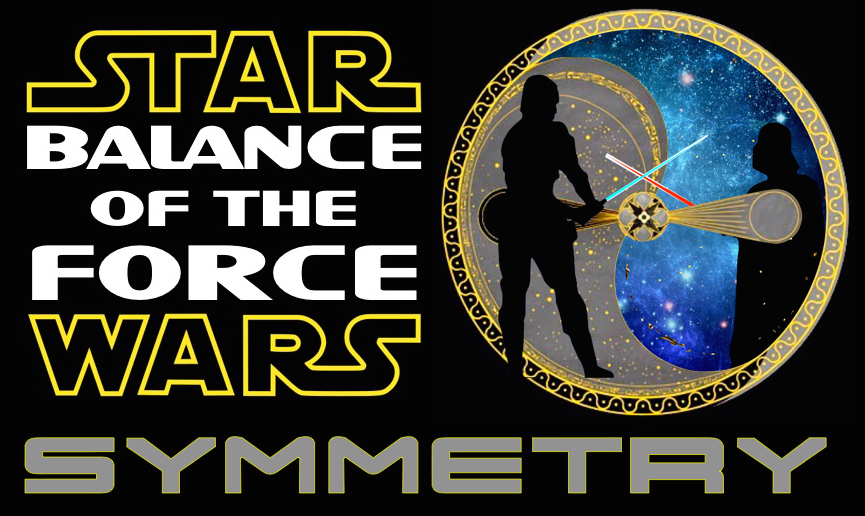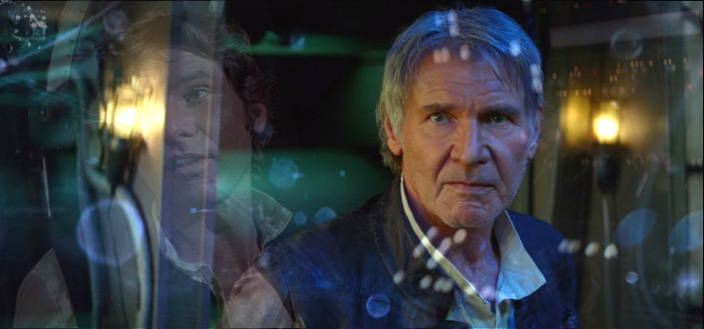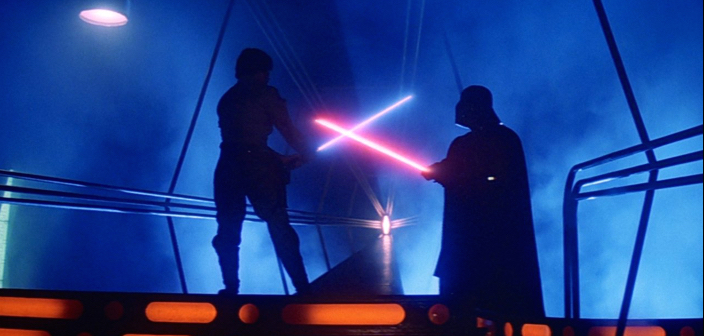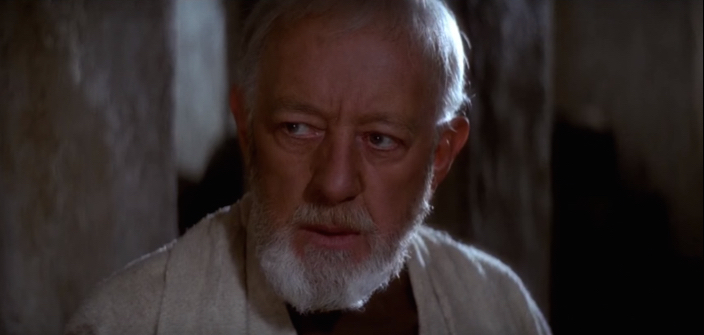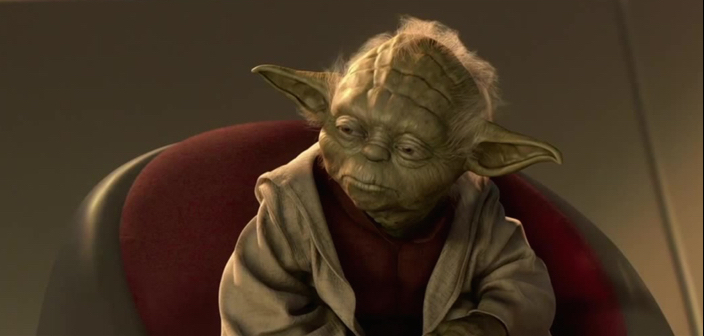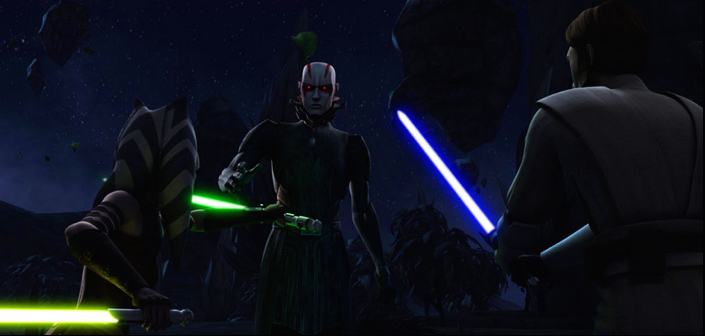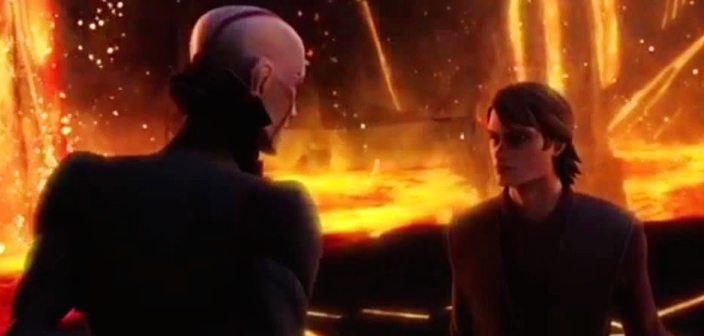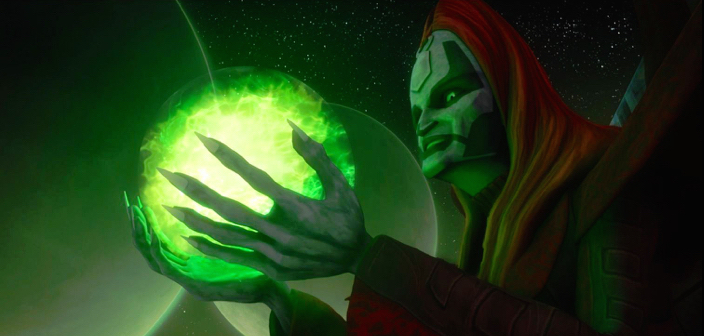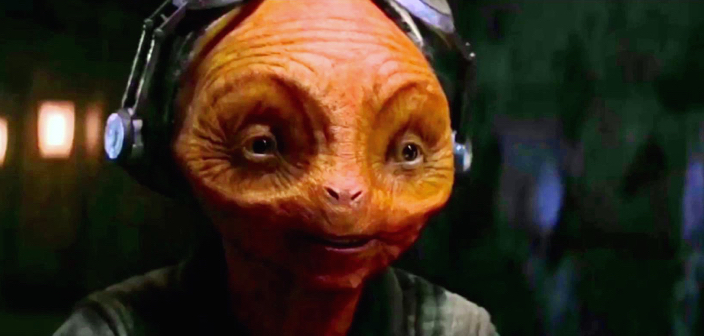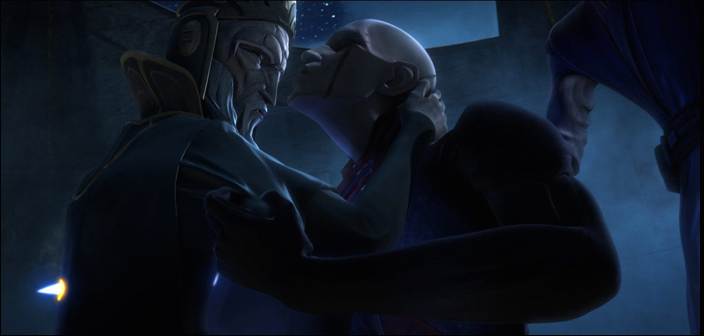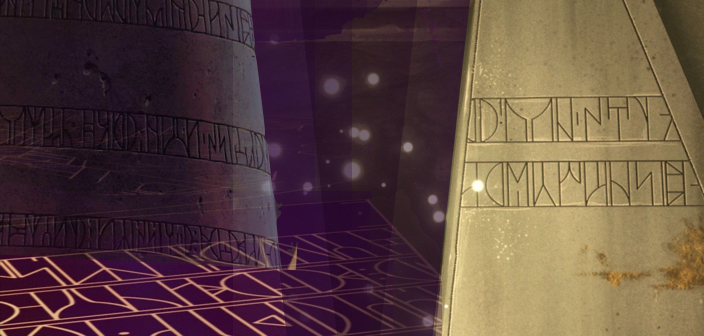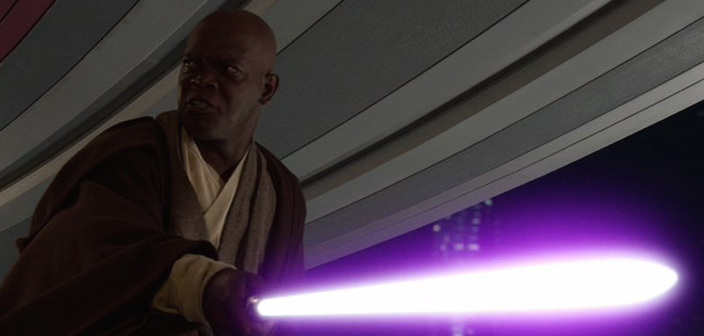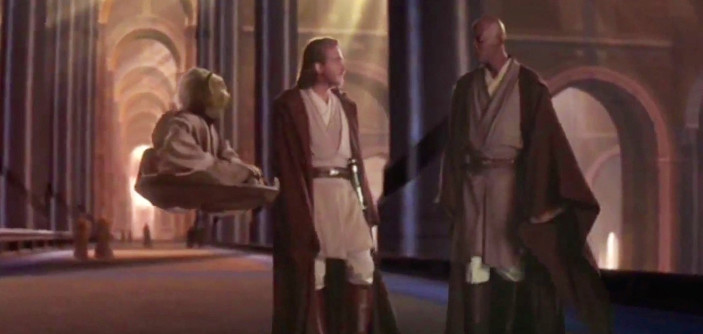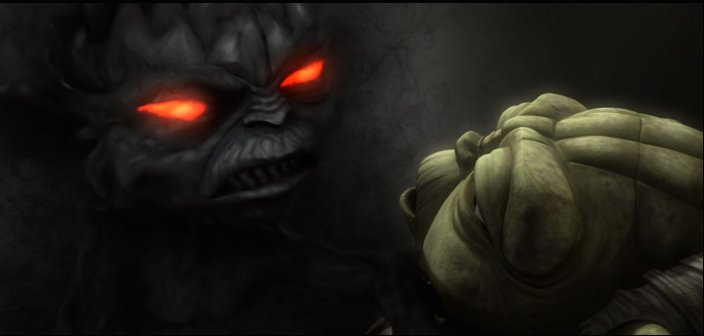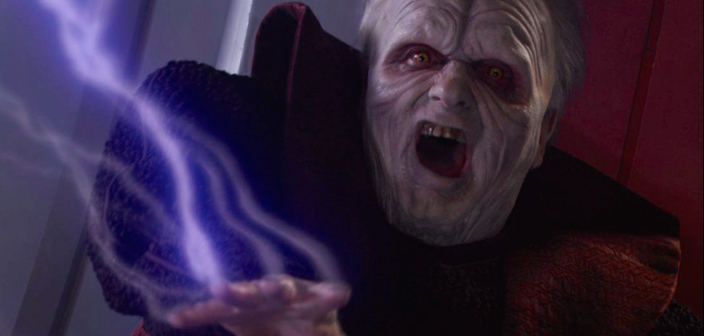Balance of the Force: Symmetry
shazbazzar
“The Jedi were real!”
“Used to wonder about that myself. Thought it was a bunch of ‘mumbo-jumbo’. A magical power holding together good and evil, the Dark Side and the Light. Crazy thing is, it’s true. The Force, the Jedi…all of it. It’s all true.”
The words of Han Solo, uttered in the same place where he had denied the idea that some all powerful Force controlled everything, renouncing the Jedi and their ways as “simple tricks and nonsense”, carried with them the weight of a teacher, a mentor, a father-figure to Rey in The Force Awakens. And rightfully so, because the audience as well as Rey needed to understand what was at stake in the galaxy.
Before Qui-Gon Jinn encountered the Sith Lord on Tatooine, the Jedi were already aware of imbalance in the Force. When he informed the Jedi Council about his discovery of Anakin on the desert planet, Master Mace Windu responded, “You refer to the prophecy of the One who will bring Balance to the Force. You believe it’s this boy?” The Force had become unbalanced at some point in the past — long enough ago for a prophecy about a Chosen One to be envisioned, accepted, and expected. Some suspected that when Anakin became Darth Vader, and the Jedi were all but eradicated, balance had been achieved with only two Sith and two Jedi remaining, but this explanation was quickly seen to be lacking, since Obi-Wan implies there are more Jedi alive than himself and Yoda when he sets the message from the Jedi Temple to transmit a warning for any remaining Jedi to go into hiding.
When all six films were viewed in chronological order, after the events of Return of the Jedi, many fans reasoned that the Force had been restored to Balance with the destruction of the Emperor, Darth Sidious, and the return of Anakin Skywalker to the Light before his fatally-wounded body finally succumbed to decades of damage inflicted upon it. Many of us had assumed some measure of “happily ever after” for our heroes and a new order of Jedi to rise under the tutelage of the last Jedi, Luke Skywalker. But when we heard that Luke Skywalker was missing and then saw a very Imperial looking First Order which had arisen from the Dark Side, we wondered what this meant to the concept introduced to us in the prequels: the Balance of the Force.
In the imagery of Star Wars, balance can either mean peace and harmony or equality and symmetry. The first article in this series addressed the idea of harmony as the balancing factor of the Force. This essay will address the idea of balance as symmetry between the Light and Dark Sides of the Force.
Balance of the Force: Symmetry
Audiences listened as intently as Luke Skywalker himself when Ben Kenobi revealed how the boy’s father had died: “A young Jedi named Darth Vader, who was a pupil of mine before he turned to evil, helped the Empire hunt down and destroy the Jedi Knights. He betrayed and murdered your father. Now the Jedi are all but extinct. Vader was seduced by the Dark Side of the Force.” Not only had we heard the first reference to the Force, but we inferred from the context that this Force consisted of a Dark Side (explicitly stated) and Light (implied). Obi-Wan Kenobi and the Jedi Knights followed the Light while Darth Vader and those like him served the Dark. These were typically referred to as “the Force” and “the Dark Side”. The beautiful symmetry of myth — light and dark, good and evil — was portrayed by heroes and villains of the saga, specifically in a white clad youngster and a masked machine-man in solid black armor. The two sides were clearly seen.
When Luke journeyed to Dagobah to continue his training with Yoda after the death of Obi-Wan, the diminutive Jedi Master revealed more about these two sides of the Force: “A Jedi’s strength flows from the Force, but beware the Dark Side. Anger, fear, aggression — the Dark Side of the Force are they. Easily they flow. Quick to join you in a fight.” The two were opposed to each other in both focus and conduct, yet neither was presented as inherently stronger than the other, as Yoda explained when Luke asked if the Dark Side was stronger, “No. Quicker, easier, more seductive.” Repeatedly, Yoda warned his apprentice of the dangers of the Dark side, telling him time and again, “Once you start down the Dark path, forever will it dominate your destiny.” To Yoda, peace could only be achieved by conquering Vader and the Emperor. Both Yoda and Obi-Wan seemed to agree that the Dark Side needed to be suppressed and even destroyed for balance to be restored.
From their point-of-view, it was easy to see why, since the prequels revealed them witnessing how a young boy’s fear led to his fall to the Dark Side. When Anakin first appeared before the Jedi Council, Yoda warned the boy, “See through you, we can…Fear is the path to the Dark Side. Fear leads to anger. Anger leads to hate. Hate leads to suffering. I sense much fear in you.” Obi-Wan agreed with Yoda’s sentiment even then, asking his Master, “The boy is dangerous. They all sense it; why can’t you?” By the opening of Attack of the Clones, the Jedi’s abilities to use the Force had been diminished due to the rise of the Sith. “The Dark Side clouds everything,” Yoda admitted, later confirming “The shroud of the Dark Side has fallen,” as the Clone War began. Throughout the prequel trilogy, viewers watched as Anakin was seduced by the Dark Side through the flattery, deception, and coercion of Senator and then Chancellor Palpatine. This Phantom Menace operated behind the scenes for more than a decade to undermine the Jedi and topple the Republic through an orchestrated war that transformed the Jedi from guardians of peace to generals over the Army of the Republic. Darth Sidious remained concealed behind the curtain as a puppet-master, pulling the strings that would eventually lead to the downfall of the Jedi and the escalation of his power as Lord of the Sith and Emperor of the Galaxy.
Throughout this period, the Jedi saw the Dark Side simply as the embodiment of evil. Evidently, the Sith were the only manifestation of the Dark Side to their knowledge. The Jedi never mention the Dark Side except in reference to the Sith. These Sith who had long ago been defeated by the Jedi had somehow arisen and were actively dismantling the Republic and threatening to destroy the Jedi, as well.
Yet again, The Clone Wars serves to give fans a more complete picture of the Dark Side and the Light. On Mortis, when Obi-Wan and Ahsoka are confronted by the Son, Obi-Wan states his belief that the Son is a Sith. The Son replies, “Sith. Yes…and no.” After the showdown in the arena between Anakin, the Son, and the Daughter, the Son invades Anakin’s sleep, appearing to him in a vision: “Anakin, it’s true what they say. You are the Chosen One. Together we can change the balance of the universe, my friend. Aligned, we can restore balance wherever we go — peace to the universe. We will destroy the Sith…and the Jedi.” In an attempt to seduce Anakin into an alliance with him, the Son casually admits that there is more to the Dark Side than simply the Sith. Balance, as was mentioned in the first part of this series (“Balance of the Force: Harmony”), can sometimes be synonymous with peace. The Son plays on Anakin’s sense of destiny while simultaneously allowing him to imagine a life free from the evils of the Sith as well as the rigid rules of the Jedi. At the same time, the seed is planted in the minds of viewers of a possibility of Light and Dark being balanced without either Jedi or Sith.
When we were finally given a few episodes from what has become known as “Season Six”, a duology called “The Disappeared” teamed Jar Jar Binks with Mace Windu on a mission to Bardotta. Overshadowed by the arc explaining how the Clone Troopers so quickly turned against the Jedi Generals through “Order 66” and the Yoda arc that signaled the end of The Clone Wars series, this two-part story has been largely forgotten and its significance, in turn, overlooked. The Bardottans branded the Jedi as kidnappers, due to their propensity to search the galaxy for Force-sensitive infants to be trained as Jedi. Probably because the Bardottans were, as a people, more attuned to the Force than many other beings, their children were more often taken to the Jedi Temple than those from other worlds. From their point-of-view, the Jedi represented a criminal element, if not actually evil. They were disdained by these people who simply wanted to protect their families and culture. Furthermore, we learn that these apparently peaceful people were adept at sensing the Force, yet they were neither Jedi nor Sith. Because of their unusual connection to the Force, Mother Talzin sought to use the spirits of the Dagoyan Masters to provide her with increased power. She revealed this to Queen Julia, saying, “I am not a natural Force Wielder like the Jedi or Sith. I use Dark Magic to achieve power. But as a Bardottan, you possess a strong connection to the Living Force — a connection that soon will be mine… With the combined power of your spirit and my Dark Magic, I will become more powerful than any Sith or Jedi.” While this leaves the door open for debate about whether the Nightsisters’ Dark Magic was some manifestation of the Force or not, it does confirm that not all Force users are Jedi or Sith; there are clearly other “orders” that call upon the Force for vision or strength.
Enter The Force Awakens. To my knowledge, there is no mention of the Sith in the movie at all. The Jedi are all but extinct, Luke Skywalker having removed himself from the galaxy in search of the first Jedi Temple. Yet there are other orders that know, revere, and even tap into the Force. Lor San Tekka proclaims, “The First Order rose from the Dark Side.” Maz Kanata tells Rey, “I am no Jedi, but I know the Force. It moves through and surrounds every living thing. Close your eyes, feel it. The Light, it has always been there. It will guide you.” Clearly, Snoke’s First Order represents the Dark Side, while Maz knows the Light. The symmetry between Light and Dark continues in the sequel trilogy, becoming larger than a battle between the Sith and the Jedi — it is a battle between good and evil, regardless of how the component parts align themselves.
Consider how Mortis represents Light and Dark, balanced by the Father who can control his children only on this unique world. He likens them to day and night, showing that neither exists without the other. This idea is consistent with the “fortune cookie” from “The Disappeared (Part One)” from season six: “Without darkness, there cannot be light.” When the Daughter is killed, the Father laments, “Lost. The balance has been broken… There is no light. The evil has been unleashed. And the Dark Side shall consume her… As the balance of this world crumbles, so shall war escalated in your galaxy. As my Son has descended into the Dark Side, so have the Sith gained strength.” Without the Daughter, the embodiment of Light, Darkness would reign over Mortis — balance was lost. Only night reigned on Mortis from that point forward. In a deleted scene from “Ghosts of Mortis”, we realize that the Son’s descent towards evil was spurned by following the ways of the ancient Sith Lords, Darth Bane and Darth Revan. Intent on the supremacy of the Dark Side, they compelled the Son to seek to control the Chosen One. Because the Son had done what these “Disciples of the Dark Side” had asked, balance had been broken on Mortis — because the Father sought to control fate and the Son sought to gain power. In the end, this imbalance resulted in the Father killing himself with the Dagger of Mortis (evidently the only thing that could kill these anchorites) and the Son being run-through with Anakin’s lightsaber. Though the Father says that this restored balance to Mortis, the galaxy was spiraling out of control without a steady hand to keep the Light and Dark in check. The Father was no more, yet the Force remained, and its strength had shifted in favor of the Dark Side.
The evidence of this inherent relationship between the Light and Dark is present in Rebels, as well, in the writing present in the Jedi Temple on Lothal as well as the Sith Temple on Malachor. That both sides share the same script shows their relationship is more similar than it has sometimes thought to be. They are two sides of the same coin — neither exists apart from the other. They are opposing sides of an isosceles triangle, if either side is shorter than the other, the symmetry — the balance — is interrupted.
Perhaps the Jedi were complicit in disrupting the balance because they focused on eliminating the Sith, the Dark Side counterpart to their own order of Light. To the Jedi, balance was supposed to exist through the suppression and even eradication of their opposition. When Anakin had dominated Count Dooku in Revenge of the Sith, Supreme Chancellor Palpatine urged the impressionable young Jedi Knight to kill the unarmed prisoner. After the final cut, Anakin’s mentor applauded his action, declaring, “You did well, Anakin. He was too dangerous to be kept alive.” Yet Anakin refused to be consoled by these words, responding, “I shouldn’t have done that; it’s not the Jedi way.” Later, when Anakin arrives in the Chancellor’s office to find Jedi Master Mace Windu about to kill Palpatine, Anakin objects, “He must stand trial.” Mace defends his choice of action, repeating the very words spoken earlier by this Sith Lord, “He’s to dangerous to be left alive.” The Jedi had forsaken their own code in an effort to maintain order and put an end to the war that had already fundamentally transformed the Jedi from their noble role of peacekeepers to Generals in the Grand Army of the Republic, pursuing and attacking Separatist forces in the Clone War, submitting to the commands of the Republic instead of the will of the Force.
How could this happen? What was the chink in the armor of these knights? What flaw was present in the Jedi? Palpatine claimed that even the Jedi were afraid to lose their power when he spoke with Anakin at the opera. Maybe his claim was true. But something more insidious had taken hold among the Jedi. When discussing Anakin’s skills with Mace and Yoda in the Jedi Temple, Obi-Wan says, “His abilities have made him, well, arrogant.” To this, Yoda responds, “A flaw more and more common among Jedi. Too sure of themselves, they are. Even the older, more experienced ones.” Arrogance. Pride. These characteristics lie at the heart of the Dark Side, as George Lucas himself said in The Clone Wars bonus feature “Secrets of Mortis” on the season three Blu Ray: “The core of the Force. I mean the Dark Side and the Light Side. One is selfless. One is selfish. And you want to keep them in balance.” Pride and arrogance are rooted in selfishness and self-centeredness. The Jedi had become so powerful and had enjoyed a peaceful existence for so long, they seemed to believe themselves to be infallible. Recall Jocasta Nu’s swift and certain response to Obi-Wan’s suggestion that the archives may be incomplete: “If an item doesn’t appear in our records, it does not exist.” Or when Obi-Wan himself denied the possibility that the Republic had fallen under control of the Dark Lord of the Sith, answering Count Dooku’s claim, “No, that’s not possible. The Jedi would be aware of it.” The Jedi had become too self-assured, too confident that their path was correct — so confident, in fact, that they failed to realize when they had strayed from that path.
This straying towards the Dark Side by allowing themselves to grow somewhat self-centered seems to have been brought about by denying they had any remnants of Darkness within them. Nowhere is this better seen than in the final episodes of The Clone Wars, when Yoda was to be trained to maintain his consciousness after death because, as the Priestess said, “He is to teach One that will save the universe from the Great Imbalance.” In his first trial to test his readiness for this training, Yoda was forced to face his own Dark Side. At first, he tried to fight it, to destroy it, to rid himself of this antiYoda, but eventually, he accepted the darkness within himself, saying, “Part of me, you are, yes. But power over me, you have not. Through patience and training, it is I who control you. Control over me, you have not. My Dark Side, you are. Reject you, I do.” Yoda then defeats his dark shadow by absorbing it within himself. Commending his wisdom, the Priestess approved, “The beast is you, and you are the beast. To deny it simply gives it power.” The flaw of the Jedi that aided in tilting the Force out of balance was in their self-inflicted deception that they had cast out any darkness within them. Believing they were pure adherents of the Light, they carelessly allowed the Dark Side to grow within them and gain power.
The Sith, on the other hand, were conscious that their goal was to disrupt the symmetry between Light and Dark. They absolutely intended for Darkness to eclipse the Light. For them, balance meant bringing peace through coercion and force. The Dark Side would reign over the galaxy as the Light had for millennia. Power would be in the hands of the Sith, and they would use the Dark Side to rule with an iron fist. None would dare oppose them, and any who did would be readily dealt with swiftly and decisively. The galaxy would plunge into darkness even as the Force collapsed into the Dark Side, and the Lord of the Sith would know what it means to have “Unlimited power!” Without a doubt, the Sith were intent on tipping the scales towards the Dark Side to achieve galactic domination and the eradication of the visible heroes of the Light, the Jedi.
Balance of the Force reminds us of the symmetry between Light and Dark, two necessary elements of the Force which must be kept in balance. These do not necessarily equate to good and evil, but to dual aspects of living beings. Just as day is countered by night, Light is countered by Dark. Birth and death, living and dying: these are both essential elements of the Force and must remain in balance for the orderly existence of the galaxy. Be sure to return to StarWarsReport.com for more articles about the “Balance of the Force”.
Author: shazbazzar
Stuart Tullis (shazbazzar) has been enamored with Star Wars since first seeing it at the drive-in with his family. The original trilogy dominated his youth until the Dark Times removed the toys from the stores in the mid-eighties. Rediscovering Star Wars at Mississippi State University with a housemate’s copy of Heir to the Empire, he has enjoyed the saga through toys, games, costumes, cartoons, TV specials, and books. Currently, he preaches for the Honeysuckle Road church in Dothan, Alabama where he lives with his wife, daughter, and son — two of which are avid Star Wars fans as well (his wife happily tolerates their fandom with a wink and a nudge). He is an active band parent who is always thrilled to hear the music of John Williams played by high school bands on the field and in concert halls. He is the co-host of TechnoRetro Dads on RetroZap.com. Follow shazbazzar on Twitter.
